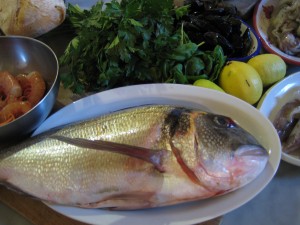 It must be orata (sea bream) season because beautiful specimens are showing up in the fish market and recently a friend called to say he’d procured two fresh caught orate from Orbitello on the Tuscan coast, and would I come over to show him how to cook them sotto sale, or under salt. Then last week for cooking class I had a special request to do an all fish menu with a whole fish sotto sale for the main course, and I found the most gorgeous 6 pound orate in the market. We baked it under several boxes of coarse salt, a procedure so simple you don’t need a recipe.
It must be orata (sea bream) season because beautiful specimens are showing up in the fish market and recently a friend called to say he’d procured two fresh caught orate from Orbitello on the Tuscan coast, and would I come over to show him how to cook them sotto sale, or under salt. Then last week for cooking class I had a special request to do an all fish menu with a whole fish sotto sale for the main course, and I found the most gorgeous 6 pound orate in the market. We baked it under several boxes of coarse salt, a procedure so simple you don’t need a recipe.
If you look on the internet or most cookbooks for a recipe for whole fish baked in salt, current chefs seem to complicate the whole procedure and have you mix kosher salt with egg whites. It’s a step that’s really not necessary, save your egg  whites for a meringue cookie. In Italy we just grab the box of sale grosso, or large salt, and cover the fish completely, giving it a good bed of an inch of salt to lie on and a nice comfy blanket of salt to put it to cook in the oven.
whites for a meringue cookie. In Italy we just grab the box of sale grosso, or large salt, and cover the fish completely, giving it a good bed of an inch of salt to lie on and a nice comfy blanket of salt to put it to cook in the oven.
A note on salt: you can find sale grosso in Italian deli’s or in a lot of supermarkets. It has a large crystal than sale fine or fine salt. It shouldn’t cost a lot of money and don’t use any of the expensive flake salts like Maldon. Never use kosher salt for anything other than salting the driveway in the winter. Kosher salt is highly processed and rends a bitter acrid saltiness to anything you use it in. While fish baked under salt doesn’t taste salty because the flesh never comes in contact with the salt, the salt you use should be a natural, sweet salt, not a processed acrid product.
When deciding what fish to bake, choose a nice plumb, like branzino (sea bass) or orata (sea bream), or even a fresh trout. Always get a fish that’s been wild caught as they’ll have more flavor. The salt acts as an airtight cover to keep the moisture in while baking and the end result is a fish that is moist and delicate and not salty.
You have the option of adding something to the fish cavity to flavor the meat, like lemon or onion slices or a sprig of parsley, but it’s not necessary. The Tuscans like to add rosemary to fish dishes, but I’ve always felt rosemary is way too strong for the delicate flavor of a white fleshed fish.
So here’s what you do: get your whole fish, gutted and with scales on. Find a baking dish big enough and put a solid bed of large grain salt down, place the fish on it and cover it completely with more salt about an inch thick. Put it in a 400 degree oven and bake it for about 40 minutes. If the fish is very small, less time; I cooked the 6 pound orata that was 4″ thick and it took an hour.
When you pull the fish out of the oven let it sit for 5 to 10 minutes. Then gently start to remove the salt crust, being careful not to open the fish or pull away the skin to expose it to the salt. When you have most of the salt brushed off the top, pick up the fish and place it on a clean board or platter. Gently pull back the skin, keeping a bowl of warm water nearby to rinse your hands of excess salt. With a large fork or fish spatula, pull off the white meat onto a separate warm platter. Work quickly but carefully. Garnish it with lemon slices and some parsley sprigs. A little black sea salt sprinkled on top gives a lovely contrast!